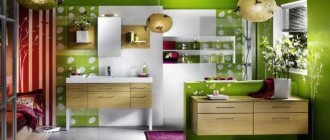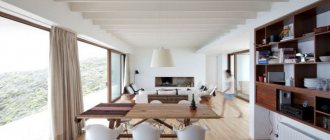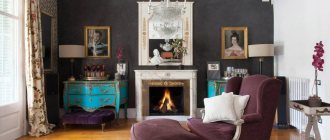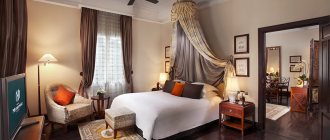A style that differs quite a bit from Baroque, moreover, it is elegant and contradictory, executed in absolute severity - this is classicism in the interior! As a rule, fairly wealthy individuals, as well as those with a high social status, decorate their own homes in this style. The application of exotic patterns, flashy and loud colors, and non-standard accessories is completely unacceptable here.
Features of classicism style in the interior
Interior colors, which mostly use brown and white tones, black and beige, can also be yellow, blue, and red. Interior decor is created using gilded finishing.
The walls are made smooth, painted in one color, without any decorations. It is acceptable to decorate the walls with expensive fabrics.
The ceiling is decorated with plaster and stucco. It can be made with a slight hint of the Ancient era.
The floors are covered with parquet made from valuable wood.
They also choose expensive furniture; the upholstery should be of very high quality. Very popular furniture with original carvings and gilding.
Lighting is thought out very carefully and designed in an original way.
Decoration elements - it is better to choose the most exclusive and unique ones.
Characteristics and style features
The dominant color scheme in the style is white, yellow shades, pink, blue, accented with gilding. Classicism requires wall decoration with textiles in pastel colors.
For added atmosphere, place frescoes on the walls. The ceiling should be made in classic white tones; it is possible to place elegant stucco molding on the ceiling borders. Classic antique stucco, no frills, thin and beautiful, can also decorate the walls; it will be an addition characteristic of the classicism style in the interior.
The floors are decorated with parquet, with a mosaic pattern in the classic colors of light wood. It is undesirable to place heavy and richly decorated carpets; observe moderation and be restrained in details, as required by the style.
To decorate windows, use only expensive natural materials - silk, taffeta, satin. Plain or jacquard-patterned curtains should be uncomplicated, without tassels or fringe.
Use the characteristic attributes of the style - antique columns (bearing indoors, or performing only a decorative function), stucco molding, wall paintings, tapestries and cozy fireplaces.
Characteristics and photos of classicism in the interior
Browse through the catalog with images of this style in interiors so that you can get inspired and start decorating your home. But classicism is incredibly elegant and graceful, majestic, triumphant. Its relevance always remains, which means that it will never go out of fashion.
When embodying a style, be sure to consider several basic aspects. Details should be symmetrical and functional and practical. The elements must be chosen precisely and luxuriously.
Classicism is an imitation of the ideals of Antiquity, found in the 17th-19th centuries. It is simply ideal to implement it by designing in multi-storey rooms or palaces.
Necessarily present here: restraint and sophistication, clear geometry and only high-quality materials.
Introduction to style
Classicism in architecture and interiors has its own special, unique distinctive features, thanks to which it stands out among similar styles. This is what we will first of all pay attention to.
Character traits
The interior in the classicism style is characterized by the following features:
- First of all, this is symmetry and clarity of layout . Moreover, this applies not only to the arrangement of furniture, lighting, decorations, but also to the design of the building itself.
Interesting fact! At the height of the style, windows and columns in passage rooms were located strictly parallel to each other (purely symmetrical), as if emphasizing the correctness of the construction of the entire interior composition.
Photo of the passage room
- Restraint when arranging scenery . But at the same time, pastel colors and minimalism only increase the overall impression of luxury and high cost.
Restraint in decoration
- The interior in the style of classicism is characterized by a predominance of light shades (mainly white) in combination with more saturated ones . The most commonly used colors are green, gold, blue, pink, brown and purple.
- The forms are correct. The most common are arched and rectangular.
Interesting interior option
- The use of columns, statues, and ornaments in the interior is relevant.
Columns are an indispensable attribute of a classic interior
- The structures are distinguished by their stability, monumentality, and massiveness.
Monumentality
- Lines are clear, repeating horizontally or vertically.
Work zone
- Windows in the premises should have a rectangular or arched shape . Their design is minimal. They are usually painted white.
Window
- The doors are high, reaching 2.8 - 3 meters. The predominant color is again white. They can be decorated with statues of a lion or an ancient sphinx. One of the basic rules remains the same - rigor and geometricity, lack of excessive pretentiousness.
Doors - almost to the ceiling
- The aesthetic component is no less important; it will add completeness. Paintings and other art objects are welcome.
Paintings complement the interior
Walls and ceilings
Classicism is an interior style that presupposes, as already mentioned, restraint combined with exquisite decoration.
The walls should emphasize the laconicism of the entire environment, which is why their excessive brightness and catchiness are unacceptable:
- As a rule, the surface is monochromatic. The shades used are light, pastel. The ideal option would be: white, beige, light shades of olive, pink, blue.
- Decorating individual areas with ornaments, paintings or stucco is encouraged.
- You can use expensive textile or vinyl wallpaper for wall decoration.
- The surface can also be plastered with decorative compounds or covered with expensive fabric.
- The emphasis can be placed on a specific area in the room by painting the surface with more saturated colors in relation to all the walls.
- The most relevant would be an image on the surface of a portrait or landscape typical of the 18th century. Frescoes in the style of antiquity are also suitable.
It is better to make the ceiling snow-white. This will visually lift it (which is good from a practical and design point of view) and create the illusion of space.
On a note! Interior design in the classicist style is best performed in rooms with high ceilings. This is an extremely important aspect. The square footage of the room itself is not so important as its height. Otherwise, the effect of the applied style may not be achieved.
The finishing of the ceilings is characterized by the following:
- It is imperative to use stucco. Often it is provided in the center of the ceiling, focusing on the chandelier.
- You can also emphasize the geometric nature of the room by creating an ornament or a suitable pattern around the perimeter of the ceiling.
- A monumental multi-level ceiling is also a good, and, most importantly, suitable solution. It can be decorated, for example, by highlighting the texture by painting individual stucco elements in a golden color.
- A complex multi-level ceiling looks advantageous in spacious rooms together with columns.
- The combination of golden and white colors will add royalty and discreet luxury to the interior.
The variability of execution is extremely wide. The photo gallery will demonstrate the most interesting designs.
Decorative elements and interior items
The classicism style in interior design requires the presence of decorative elements. Despite the restraint, they give the room majesty. With proper placement and use of such items, you can create the illusion of being in an 18th century building.
Worth using:
- Pilasters;
Pilasters
- Half columns;
Half-columns and columns
- Frescoes.
Fresco
On the walls you can place mirrors of regular geometric shapes, decorated with baguettes. Cornice, curtains with lambrequins, furniture covers are integral parts of the interior in the classicism style.
Classic assumes the presence of porcelain dishes and figurines, books, antiques and paintings.
Classic style dishes
Note! Many interior items can be decorated by applying stucco in the form of a lion's head, images of griffins, birds, cupids, sphinx, and medallions. The following types of ornaments can be used: meander, cymatium, garland.
Ornaments, description, instructions
Classicism in the interior can be emphasized by such an object as a fireplace. With appropriate finishing, you can even use it to create a recreation area, placing emphasis on it while maintaining the overall style.
You can install the fireplace yourself
On a note! You should not place too many small decorative elements. When choosing between a small figurine and a floor vase of impressive dimensions, choose the latter. Hang pictures also in large sizes.
Furnishing
The classicism style in the interior is characterized by the presence of expensive furniture made of valuable types of wood, such as cherry, walnut, Karelian birch and some others. The inlays on the furniture are very original, but not pretentious.
More about furniture:
- The option of decorating such items with stones is absolutely excluded. But having an ornament won’t hurt at all.
- Armchairs and stools have thin, graceful legs that taper downward. The seats and backs are upholstered in high-quality fabric with a floral pattern.
- The combination of mahogany with bronze decoration looks most successful.
- Furniture can have inserts made of valuable wood.
- The general appearance of such interior items is distinguished by massiveness, good quality, high cost and peculiar simplicity.
On a note! When decorating an apartment or house in the classicist style, difficulties may arise when arranging modern equipment, because with its appearance inappropriate for the 18th century, it can significantly disrupt the harmony of the interior. That is why it is worth approaching this issue with all responsibility and competently “hiding” the technique or trying to “fit it in”.
Well-fitted TV
Lighting
Lighting is also an important interior detail:
- Chandeliers are massive. As a rule, they have numerous crystal pendants.
- On the walls you can place lamps decorated with gilding or imitation.
On a note! Spotlights will also fit quite organically into the style of the room. Indeed, in the 21st century, when complementing classicism in the interior, the use of modern elements is acceptable. After all, it is almost impossible to accurately replicate the situation of the 18th century.
- Pay attention to antique items or handmade chandeliers.
- Chandeliers with candle shades look very advantageous. The latter look exceptional in bronze color combined with crystal. This design option will only emphasize the classic style of the interior and create a medieval atmosphere.
- Floor lamps with fabric decoration with floral patterns can be placed on the floor.
- Place them next to the chairs and they will create coziness.
- Keep in mind that lighting can influence the visual shape of a room and its color.
Ceilings
It is quite appropriate here to decorate with luxurious ceilings consisting of multi-level structures. Despite their recent origins, they are already quite popular in the market in their segment. They are organic and beautiful, suitable for decorating a room, palace, villa, apartment.
Stucco molding is absolutely necessary here, but it should be made in non-standard, and maybe even unusual shapes. It is with its help that the overall impression of interior design in the classicism style will be formed!
A little bit of history
For a better idea, let’s look into the past and briefly get acquainted with the history of the origin, formation and development of the style.
- The birth of classicism took place at the end of the distant 16th century in Western Europe. It gradually began to supplant the pompous Rococo style, which was widespread at that time, which by the middle of the 17th century was subject to serious criticism precisely because of its incontinence.
- In contrast, the interiors of the Classical era were distinguished by laconicism, clarity and rigor. The style was based on the architecture of antiquity, which began to especially attract contemporaries.
- This was facilitated by the formation of a different view, first of all, on Greek culture.
- The origin of the style in question is the result of the transformation of Renaissance architecture.
- Classicism manifested itself most clearly in the mid-18th century. At this time he was experiencing a special upsurge.
- Buildings, palaces, temples and even entire ensembles were built, which have survived to this day.
- The richest segments of the population willingly decorated their real estate in this style.
- The interior of a noble mansion in the classicist style was characterized by monumentality, restrained luxury and symmetry.
- However, not all countries followed the same trends - English and French classicism followed slightly different paths.
English version
- The British relied on late Renaissance traditions, while the French partly absorbed Baroque traditions.
Interior of the Elysee Palace in France
- And even today, classicism in a modern interior may contain elements of other styles characteristic of the 18-19 centuries.
Furnishings
Furniture, like everything else, should be expensive in classicism. At the same time, original designs must be present here. The upholstery comes with colorful patterns of plant motifs.
Pay attention to window design. The decoration of velvet, silk, brocade is very appropriate here; heavy porters can be decorated with tassels, as well as gilding.
And the highlight of the style will be the fireplace, which is decorated with carvings, stucco molding, and forging. It will be the hearth where your family and friends will gather.
The interior in question is calm and solid, correct and laconic. The design is not overloaded, not harsh. And all this confirms the refined taste of the inhabitants.
When decorating classicism in your own home, you need to try hard!
Gold is everywhere
Chest of drawers in the style of Louis XVI, J. G. Beneman
In the era of classicism, gold elements were present in almost every piece of furniture: chests of drawers and bureaus, chairs and ottomans, stucco molding and textiles.
Louis XVI, the third in the line of Louis, just like his predecessors (we mentioned Louis XIV in the article on the Baroque), had an important influence on culture and art. During his reign, the decorations changed from lush and pompous to clear, strict and harmonious. Artists turn to antiquity and draw inspiration from simple shapes and clear lines. Today we can see the rigor and precision of the classicism style in minimalism
, which speaks volumes about its relevance more eloquently than any words.
Children's room
A children's room decorated in classicism style is the room of a little princess. It can be decorated in soft pink or lavender. If space allows, it is better to place the bed in the middle of the room; if this is not possible, it will look good against the wall.
For clothes, you can choose a closet with mirrors on the doors, and a chest of drawers will come in handy for storing small toilet parts. We must not forget about the place to study. A table with curved legs paired with a chair will perfectly complement the picture of a children's room in the classicist style. Being in such a room, a child will be instilled with good taste from childhood.
Do you need construction services?
The interior in the “ Russian classicism ” style had (and still has) many characteristic features, and we want to talk about them. The main “culprit” for the emergence of a new style in Russia (with a bit of a joke) is considered to be a chair. Having “seen” European chairs, our ancestors, who returned from Europe, began to copy these products, and it soon became clear that changes in the “look” of the chair should also affect changes in the appearance of other pieces of furniture. Of course, this was not the main and far from the only prerequisite for the emergence of Russian classicism, but the fact that the chair “pushed” our ancestors to rethink the appearance of the premises is obvious. Of course, the main reason for the emergence of a new style was the orientation toward European classicism, and gradually a new style with features unique to Russia began to prevail in Russia. The main “driving force” was furniture. The construction of St. Petersburg required not only a huge amount of building material, but also furniture, of which little was produced in Russia at that time. That is, there was enough furniture for residents of other cities, but the city on the Neva required not only an increase in its production, but also the opening of factories for its production. The difficulty was that the new style, “brought” from Europe, was not familiar to furniture makers. The problem was solved in the following way: specialists came from Europe to Russia and, while making furniture for St. Petersburg, trained Russian craftsmen during the production process. Russian craftsmen quickly learned to make new furniture and later began to introduce Russian features into it. Despite the increase in furniture production, there was a shortage of it until Catherine’s time. But we will talk about these times later. Let us now remember that the conversation about Russian classicism began with a story about a chair. And to him (and to the story, and to the chair) we return...
The chair did not immediately settle in the center of the room (behind the table). Since previously there were benches along the walls, the chairs, “displacing” these pieces of furniture, took their place and were arranged in the same way as the benches. But as the interior was transformed, the chairs began to leave their places along the wall. Along with the “migration” of chairs, their “depreciation” occurred. If in earlier times a chair was something privileged, then with the advent of the classical interior, the chair “lost its former greatness” and increasingly began to appear not only in palaces, but also in the homes of ordinary citizens. The chair turned out to be in the “best position”. They did not treat it “familiarly”, as they began to treat the chair, and the position of the chair in the house was more “elevated”. An armchair, unlike a chair, had one owner and was, as a rule, part of an office. Often the chair was installed in the living room.
But chairs and armchairs, naturally, were not the only pieces of furniture reflecting Russian classicism . As a matter of fact, in the era of Peter I there was no such concept. As we said above, Russian furniture makers did not immediately begin to produce furniture with features characteristic of Russia. And the interior decoration almost exactly copied the European decoration. Moreover, there was often a mixture of styles, since everything new was “imported” from different countries, and, as we remember, the classicism of one country was different from the classicism of another. Therefore, “heavy” German cabinets, French tables with carved legs, mahogany beds, so beloved by the British - all this (as well as canvases, wall decoration with wooden panels and fabrics, parquet floors) at the beginning of the 18th century represented a classic interior in palaces Russia.
But over time, classicism, “brought” from Europe, began to acquire new features, which served as prerequisites for the emergence of its own style - “Russian classicism”. (We are talking about furniture for now, since it is furniture that most clearly demonstrates the character of this style). At the end of the 18th century, furniture in Russia “got rid of bulkiness” and acquired elegance. The backs of chairs and armchairs began to be made lower, the seats wider. The carving, present on almost all pieces of furniture, repeats not only floral patterns, but also rock patterns, reflecting the shape of a sea shell. Moreover, craftsmen began to use “volumetric” painting of furniture, separating the background from the carvings with tones.
But it would be wrong to assume that only furniture was the driving force that “led” Russia to classicism. For this style to emerge, there was a need for harmony between the pieces of furniture and the decoration of the walls, ceilings, and also with everything that was supposed to be present in the room. But this harmony would not be enough for the emergence of a new style. It was necessary to have unity of styles in architecture, sculpture, painting and other areas of art in order for Russia to announce to the whole world about a new style for that era - Russian classicism. And such unity began to appear in the 19th century. Pretentiousness and pomp were replaced by softer features in the architecture, which left its mark on the interior. The estates being built throughout the country no longer looked like palaces, and the furnishings in the premises began to have a more homely character. A situation arose similar to the situation in Germany, when the Germans began to prefer a new style - Biedermeier (we paid a lot of attention to this style in one of our previous conversations). In part, Russian classicism had common features with this German style, but Russian “touches” gave the style originality.
It is no coincidence that we pay increased attention to Russian classicism , since it attracts a lot of attention from owners of country houses, and today you can see many buildings reflecting that era, where the interior transports their owners and guests to the 19th century.
We will talk about these “touches”, as well as how Russian classicism fell into decline, in the next part of the article.
Alexey Kaverau
The article uses photographs of the sites: h-master, luxurywood (2 photos), mmmebl, clasicizm
Tips for choosing furniture in the classic style
Furniture in the classicism style is luxurious, but at the same time simple and laconic, each shape has straight lines. For the manufacture of furniture, exclusively natural wood is used; greater preference is given to such types of wood as cherry, walnut and Karelian birch.
Silk, natural stone, metal and much more are used to decorate furniture. Often, handmade work is used to make furniture - wood carving, inserting precious stones. When choosing tables and chairs, you should pay attention to their legs. They should be graceful and curved.
The main element of the interior is the presence of a secretary with a built-in hiding place. There have been cases where this piece of furniture kept more than one secret for many decades. When making it, craftsmen use wood, bronze and marble, and decorate the secretaire with figurines made of jasper or mother-of-pearl.
Classicism style today
Today, the classicism style is actively used in interior design. Anyone who wants to emphasize their status will definitely choose this option. The style demonstrates the good taste of the owner of the apartment.
You can easily recognize the classicism style by the quality and cost of finishing materials, furniture and accessories - wood, rich and natural materials, stone and of course gold. Classicism is great for decorating spacious rooms, but can also be an ideal option for an average apartment. You just have to choose the right primary colors and place accents.











